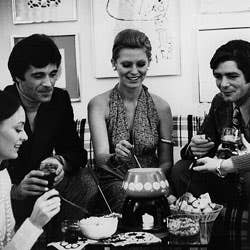
How Do You Fondue?
Back in the days of bell bottoms, ironed hair, and harvest gold kitchen appliances, fondue parties were all the rage. The 1970s have returned with a vengeance, and so, it would seem, has fondue. Gone are the simple communal pots in frighteningly drab earth tones—nowadays, fondue has gone gloriously high-tech, complete with LED heaters, fashionable finishes, and even funky shapes, such as one that looks likes a Hershey's Kiss.
But how did it all begin? The word fondue simply means "melted" in French and specifically refers, in the culinary sense, to melted cheese. Fondue was originally created out of necessity by people living in remote villages in the Swiss Alps. With only local food sources to sustain them during harsh winters, they found that melting stale cheese renedered it not only edible, but delicious, and that even dried-out bread became quite good when dunked in this creamy concoction.
Many varieties of the Classic Swiss Fondue now exist, with each cuisine adding its own twist—special seasonings, regional cheeses, different cooking liquids. For example, the Fondue Savoyarde of the French Alps calls for beaufort cheese and Savoyard white wine, while the traditional Fonduta of Italy's Piedmont region employs a sweeter fontina cheese and egg yolks. As for American Fondue, well, we've evolved beyond the days of melted Velveeta—we recommend using a good artisanal cheese and American-distilled cherry brandy.
But don't feel like you have to choose just one recipe to try—each one is as delicious as the next, and fondue is a dish best served to a crowd. Create your own tasting party with our recipes, your cheese-loving friends (brush up on the basics with our Fondue 101 primer beforehand), a few good loaves of bread, and you too can fondue.
Keep Reading
Continue to Next Story










